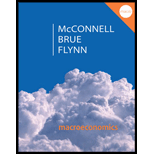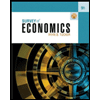
Changes in Equilibrium GDP .
Explanation of Solution
Table -1
|
(1) Real domestic output |
(2) Aggregate expenditure, private closed economy |
(3) Export (in billions) |
(4) Import (in billions) |
(5) Net export (in billions) Private closed economy |
(6) Aggregate Expenditure (in billions), open economy |
| $200 | $240 | $20 | $30 | -$10 | $230 |
| $250 | $280 | $20 | $30 | -$10 | $270 |
| $300 | $320 | $20 | $30 | -$10 | $310 |
| $350 | $360 | $20 | $30 | -$10 | $350 |
| $400 | $400 | $20 | $30 | -$10 | $390 |
| $450 | $440 | $20 | $30 | -$10 | $430 |
| $500 | $480 | $20 | $30 | -$10 | $470 |
| $550 | $500 | $20 | $30 | -$10 | $510 |
The net export can be calculated by using the following formula.
Substitute the respective values in Equation (1) to calculate the net export at the real output $200.
The net export is -$10 billion.
The aggregate expenditure (AE) of open economy can be calculated by using the following formula.
Substitute the respective values in Equation (1) to calculate the aggregate expenditure at the real output $200.
The aggregate expenditure of open economy is $230 billion.
Table -2 shows the value of net export and aggregate expenditure of open economy that obtained by using equation (1) and (2).
Table -1
|
(1) Real domestic output |
(2) Aggregate expenditure, private closed economy |
(3) Export (in billions) |
(4) Import (in billions) |
(5) Net export (in billions) Private closed economy |
(6) Aggregate Expenditure (in billions), open economy |
| $200 | $240 | $20 | $30 | -$10 | $230 |
| $250 | $280 | $20 | $30 | -$10 | $270 |
| $300 | $320 | $20 | $30 | -$10 | $310 |
| $350 | $360 | $20 | $30 | -$10 | $350 |
| $400 | $400 | $20 | $30 | -$10 | $390 |
| $450 | $440 | $20 | $30 | -$10 | $430 |
| $500 | $480 | $20 | $30 | -$10 | $470 |
| $550 | $500 | $20 | $30 | -$10 | $510 |
Multiplier can be calculated as follows.
The multiplier is 5.
Given the multiplier, the marginal propensity to consume (MPC) is calculated as follows,
The marginal propensity to consume is 0.8.
From table 1, before the addition of government expenditure (G), the open private sector equilibrium is at $350 billion.
When the government expenditure of $20 billion is added, the AE increases and increases the equilibrium level of GDP. Due to the multiplier effect, the equilibrium GDP increases by $100 billion
Whereas, the $20 billion increase in taxes initially reduces consumption by $16 billion
Thus, the net change from this balance between the government spending and taxes is $20 billion
Concept Introduction:
Aggregate Expenditure (AE): It is the total value of spending in the economy during a period of time at given price level.
Equilibrium gross domestic product (GDP): Equilibrium GDP occurs at the point where the aggregate expenditure equals to the real domestic output.
Multiplier effect: It describes how an injection to the economy via increase in government spending, investment spending, consumer spending and so forth create a ripple effect in the real output (increase) of the economy.
Marginal Propensity to Consume (MPC): It measures the amount of disposable income that consumers are willing to spend on goods and services.
Want to see more full solutions like this?
Chapter 11 Solutions
Macroeconomics: Principles, Problems, & Policies
- How sustainable is the forestry industry in BC in your opinion? Not at all, somewhat, very and explain your reasoning.arrow_forwardIn a paragraph, no bullet, points please answer the question and follow the instructions. Give only the solution: Use the Feynman technique throughout. Assume that you’re explaining the answer to someone who doesn’t know the topic at all. 6.Draw a standard Commercial Bank Balance Sheet and briefly explain each of the main components.arrow_forwardC1 The following model can be used to study whether campaign expenditures affect election outcomes: voteA = 0 + B₁ log(expendA) + ẞ₂ log(expendB) + ẞ3 prtystrA + u, where voteA is the percentage of the vote received by Candidate A, expendA and expend are campaign expenditures by Candidates A and B, and prtystrA is a measure of party strength for Candidate A (the percentage of the most recent presidential vote that went to A's party). == (i) (ii) (iii) (iv) What is the interpretation of B₁? In terms of the parameters, state the null hypothesis that a 1% increase in A's expenditures is offset by a 1% increase in B's expenditures. Estimate the given model using the data in VOTE1.DTA and report the results in usual form. Do A's expenditures affect the outcome? What about B's expenditures? Can you use these results to test the hypothesis in part (ii)? Estimate a model that directly gives the t statistic for testing the hypothesis in part (ii). What do you conclude? (Use a two-sided…arrow_forward
- In a paragraph, no bullet, points please answer the question and follow the instructions. Give only the solution: Use the Feynman technique throughout. Assume that you’re explaining the answer to someone who doesn’t know the topic at all. 10. What is Tinbergen’s constraint? Explain its importance in regard to US monetary policy.arrow_forwardIn a paragraph, no bullet, points please answer the question and follow the instructions. Give only the solution: Use the Feynman technique throughout. Assume that you’re explaining the answer to someone who doesn’t know the topic at all. 8. How does monetary policy supposedly translate into changes in AD?arrow_forwardIn a paragraph, no bullet, points please answer the question and follow the instructions. Give only the solution: Use the Feynman technique throughout. Assume that you’re explaining the answer to someone who doesn’t know the topic at all. 2. Carefully explain either Keynes’ “cookie jar” motive for holding money or the “saw-toothed model’s” motive for holding a safety stock.arrow_forward
- In a paragraph, no bullet, points please answer the question and follow the instructions. Give only the solution: Use the Feynman technique throughout. Assume that you’re explaining the answer to someone who doesn’t know the topic at all. 7.Carefully explain the Fisher equation for interest rates. What insight does it provide?arrow_forwardIn a paragraph, no bullet, points please answer the question and follow the instructions. Give only the solution: Use the Feynman technique throughout. Assume that you’re explaining the answer to someone who doesn’t know the topic at all. 3. Describe the general architecture of the Federal Reserve System.arrow_forwardIn a paragraph, no bullet, points please answer the question and follow the instructions. Give only the solution: Use the Feynman technique throughout. Assume that you’re explaining the answer to someone who doesn’t know the topic at all. 1. Define money. Carefully explain the three functions of money.arrow_forward
- In a paragraph, no bullet, points please answer the question and follow the instructions. Give only the solution: Use the Feynman technique throughout. Assume that you’re explaining the answer to someone who doesn’t know the topic at all. 5.Draw the Federal Reserve System’s Balance Sheet and briefly explain each of the main (highlighted in the PowerPoints and text) components.arrow_forwardIn a paragraph, no bullet, points please answer the question and follow the instructions. Give only the solution: Use the Feynman technique throughout. Assume that you’re explaining the answer to someone who doesn’t know the topic at all. 9. What are monetary rules? How are they carried out and what is the difference between monetary rules and discretionary behavior?arrow_forwardIn a paragraph, no bullet, points please answer the question and follow the instructions. Give only the solution: Use the Feynman technique throughout. Assume that you’re explaining the answer to someone who doesn’t know the topic at all. 4. What is interest payment on reserve balances used for? How does it work?arrow_forward




 Survey of Economics (MindTap Course List)EconomicsISBN:9781305260948Author:Irvin B. TuckerPublisher:Cengage Learning
Survey of Economics (MindTap Course List)EconomicsISBN:9781305260948Author:Irvin B. TuckerPublisher:Cengage Learning





